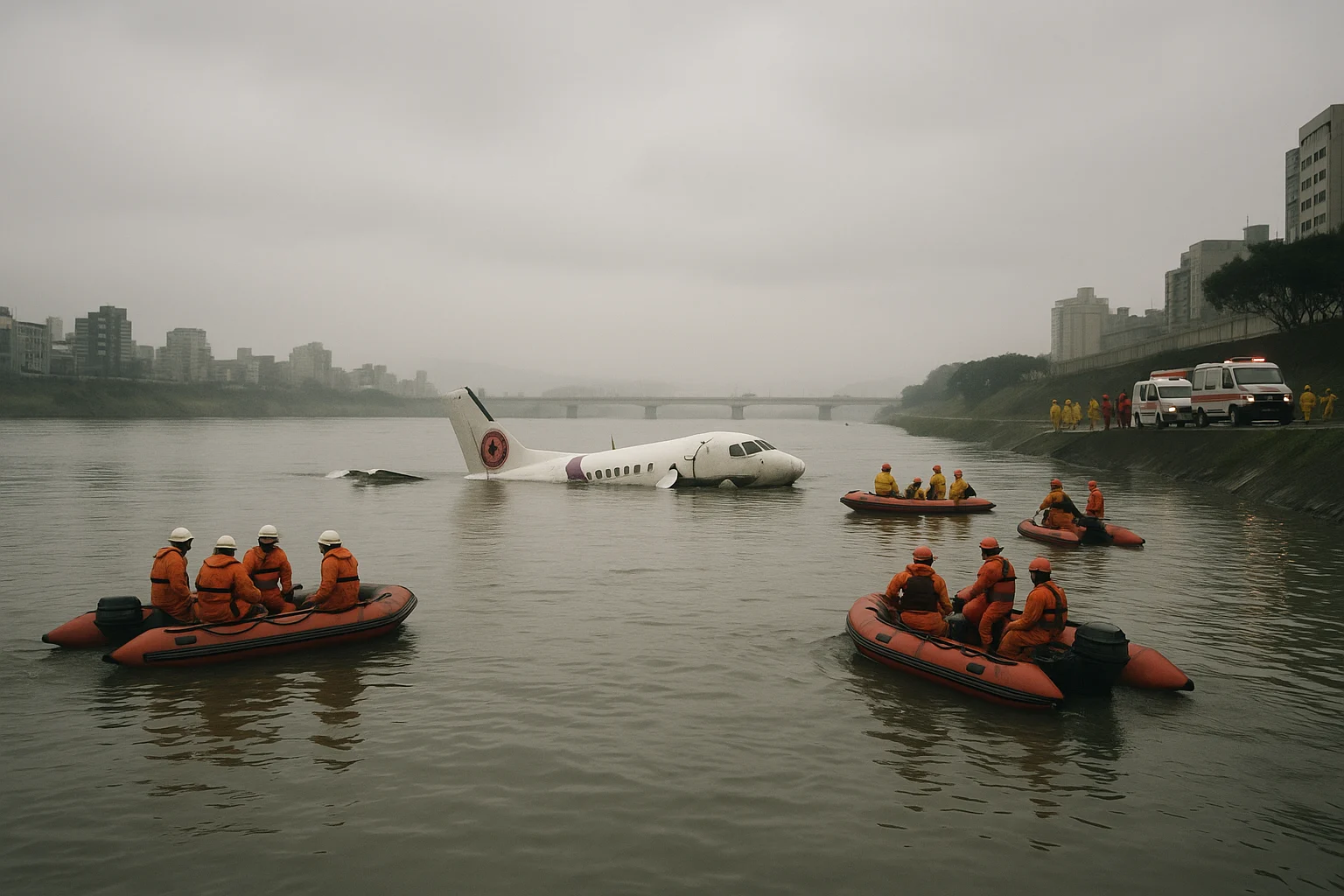
TransAsia Airways Flight 235 Crash
by: The Calamity Calendar Team
February 4, 2015
A Fateful Journey Begins
With the sun barely rising over Taipei the morning of February 4, 2015, the city bustled with its usual weekday rhythm. Taxis weaved through morning traffic, and locals began their daily routines. At Taipei Songshan Airport, passengers of TransAsia Airways Flight 235, a mix of vacationers, business travelers, and a few returning home, prepared to board their flight. It was to be a short trip across the Taiwan Strait to Kinmen Island, a common route for the ATR 72-600, whose engines had reliably hummed since its introduction to service just months prior.
In the cockpit, the pilots conducted their pre-flight checks in routine fashion, unaware that within minutes of takeoff, their judgments would be scrutinized in one of the deadliest aviation incidents to hit Taiwan in recent years.
Taking Flight
10:51 AM. The aircraft slowly taxied to the runway, symbolic of yet another seamless day in aviation. The skies were cooperative, offering little to no turbulence as Flight 235 took off into the mid-morning air. For a brief moment, everything seemed in place. Families and solo passengers settled in, likely exchanging polite nods or retreating into their thoughts, the airplane's ascent felt smooth against the backdrop of the Taipei skyline.
But tranquility was deceitful. At 10:53 AM, panic began to emerge in the cockpit when a master warning erupted. An engine issue sent alarms through the cabin and the pilots' serenity shattered. Yet, it wasn't the faulty right engine that sealed the fate of Flight 235 but a decision made in the haze of urgency—a critical mistake where the functioning left engine was mistakenly cut off.
The Plunge into Crisis
Almost immediately, the aircraft began to lose altitude. Pilots sent hurried messages to air traffic control, their voices tight with urgency, trying desperately to understand what had gone wrong and struggling against time to correct it. As 10:54 AM came, the looming shadow of the aircraft became a harbinger of chaos.
The plane veered left, its final path leading directly over an elevated expressway. On any typical day, the Taiwanese streets ran with the hum of life, oblivious to the conflicts unraveling above. But that chill February morning, a taxi driver unwittingly became part of the disaster. The aircraft clipped the vehicle, a jarring moment that was both shock and testament to the frailty of life.
Thanks for subscribing!
At 10:55 AM, the aircraft’s body met the waters of the Keelung River with a force that scattered wreckage across the surface, a scene of destruction marking the sudden end of 43 lives and the miraculous survival of 15.
The Immediate Response
In the chaotic aftermath, the response was swift. Emergency services descended upon the riverbanks, joined by locals who witnessed the harrowing descent. Determination filled the air as rescuers worked frantically amid the gray, overcast early light of February, seeking life within the grim wreckage scattered across the river—a testament to human resilience facing confusion and tragedy.
Bodies and survivors, some barely clinging to life, emerged slowly from the chilling waters. Remarkably, the two people in the taxi sustained only minor injuries, spared by chance from a much grimmer fate.
Unraveling the Tragedy
As shockwaves of the disaster reverberated through Taiwan and the greater aviation community, the government’s Aviation Safety Council mobilized an extensive investigation. The gravity of the incident necessitated expertise from international entities. French aviation experts, along with the aircraft's manufacturer, lent their skills to piece together the unfortunate narrative.
The findings were somber: pilot error. The pressure and haste of misjudging engine failure were catastrophic. The report, released in 2016, highlighted not only these errors but also the necessity for stringent training protocols within the aviation industry, with implications for aircraft operation procedures worldwide.
The Aftermath and Aviation's Reckoning
For TransAsia Airways, the implications were profound. Already grappling with reputational damage from previous incidents, this crash was a devastating blow. Public confidence reeled, financial stability wavered, and by the close of 2016, operations halted entirely.
Yet, beyond the airline's downfall, the disaster echoed a graver call for improved standards and training across airlines—learning paths forged in tragedies promising prevention of recurrence.
A Legacy of Loss and Learning
In the years since that ill-fated February morning, while the waters of Keelung River flow calm once again, the shadow of Flight 235 lingers in memory. This disaster, marked by errors and human fragility, serves as a solemn chapter for aviation history. The narrative, while heartbreaking, is a reminder of the dire need for diligence in the safety of human lives riding the skies.
For those who lived, for the lives cut short, and for an industry perpetually chasing the specter of safety—Flight 235’s lessons fuel the unwavering pursuit of vigilance, ensuring skies safeguard hope rather than grief.
Stay in the Loop!
Become a Calamity Insider and get exclusive Calamity Calendar updates delivered straight to your inbox.
Thanks! You're now subscribed.